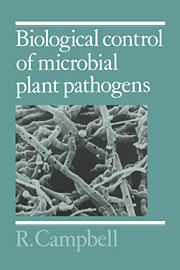Book contents
- Frontmatter
- Contents
- Preface
- 1 Introduction to plant pathology and microbial ecology
- 2 Historical and commercial background and methodology of biological control
- 3 Biocontrol on leaf surfaces
- 4 Biocontrol of stem diseases
- 5 Biocontrol of diseases of roots
- 6 Biocontrol of diseases of flowers and fruit
- 7 Biocontrol of diseases of seeds and seedlings
- 8 Conclusions and perspectives
- Glossary
- References
- Expanded index of pathogens
- Expanded index of antagonists
- Subject index
2 - Historical and commercial background and methodology of biological control
Published online by Cambridge University Press: 02 December 2009
- Frontmatter
- Contents
- Preface
- 1 Introduction to plant pathology and microbial ecology
- 2 Historical and commercial background and methodology of biological control
- 3 Biocontrol on leaf surfaces
- 4 Biocontrol of stem diseases
- 5 Biocontrol of diseases of roots
- 6 Biocontrol of diseases of flowers and fruit
- 7 Biocontrol of diseases of seeds and seedlings
- 8 Conclusions and perspectives
- Glossary
- References
- Expanded index of pathogens
- Expanded index of antagonists
- Subject index
Summary
Historical background
Biological control, in its widest sense, has been used by man almost since the beginnings of organized arable agriculture. In the third and fourth millennia BC, fallowing, limited forms of crop rotation and mixed or inter-cropping were used in the fertile crescent of the Middle East and later by the Chinese. More recently the Saxon and medieval field systems of Europe also used simple rotation and fallow periods to try to reduce disease and increase fertility. The term biological control was coined in connection with the control of insect pests by the introduction of predators (Howard, 1916, Smith, 1919, in Cook & Baker, 1983; Baker, 1987). The use of non-pathogenic micro-organisms to control plant disease occurred at almost the same time, but was not specifically called biological control. Mechanisms of action were also being investigated, and in 1928 Fleming discovered a particular antibiotic, penicillin, which was later isolated, purified and chemically characterized by Florey, Chain and co-workers.
In the 1920s there was a sudden increase in the number of publications reporting the control of disease by antagonistic fungi, actinomycetes or general soil populations. Thus in 1921 Hartley introduced antagonistic fungi, isolated from soil, to control damping off in pine seedlings (Fig. 2.1) in partially sterilized soil, though the effect was apparent in field soil. There are complications in the modern interpretation of this experiment because there were obviously toxicity problems due to sterilization, and the added saprophytic inoculum did give growth improvement in the absence of the pathogen.
- Type
- Chapter
- Information
- Biological Control of Microbial Plant Pathogens , pp. 41 - 65Publisher: Cambridge University PressPrint publication year: 1989

